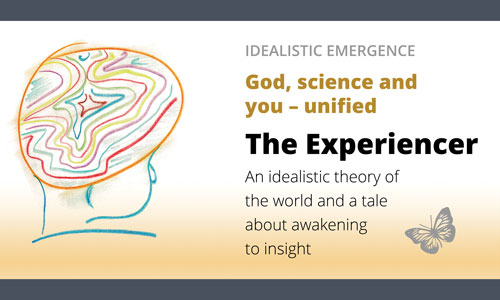15.11. Mass = kinetic energy
How the Experiencer experiences and interprets accumulations in the underlying spacetime, we can not know. Everything is too small; we lack the instruments and methods.
What we do know, however, is that quarks are perceived to have mass. We can imagine that the building blocks of the quarks, and the building blocks' building blocks, etc., also have mass.
In short, we can theorise that the accumulations in spacetime are interpreted as some unknown miniature particle, a mini-lump and that the associated qualia include the experience of mass, something «heavy».
But what is mass, fundamentally speaking?
We know from physics that energy and mass are directly related and can be transformed from one to the other through the most famous equation ever formulated, E=mc2.
How are we to understand this?
In physics, the theory is that the particles in the atomic nucleus interact with a field, the Higgs field, which gives them a small part (2 per cent) of their mass.
The rest (98 per cent) comes partly from movements – the fact that the quarks buzz around at the speed of light in clusters of three, i.e. the kinetic energy of the quarks. Part of it also comes from the «opposite» energy, the force, which keeps the quarks together in clusters – because energy is mass.
Is it possible to intuitively understand that kinetic energy can be experienced as mass?
Sure!
Imagine a rock attached to a reasonably long rope, a sling.
When the stone is at rest, it has a mass – of, for example, 1 kilogram.
If you then hold it steady a few centimetres above your head and next release it, you will feel this kilogram plus a little more, which comes from the fact that the stone gained speed when it fell.
In the fall, potential energy was converted into kinetic energy so that the stone that hit your head was perceived as «something a little heavier» than the stone's inherent weight at rest.
Then swing the stone around and around and release it with great speed.
If now the stone hits something, a head, or preferably a wall, the kinetic energy will be deadly. It will feel like being hit by a ton of mass.
The stone is the same, but the energy is greater, so the mass is experienced as greater, too.
The quarks have, according to physics, received a tiny mass from the Higgs field, but in addition, they swirl around in a small area with something close to the speed of light – like slings.
The Experiencer has thus conceptualised that kinetic energy is experienced as mass. That is a fact because Einstein's famous equation says that this is so.
The experience of kinetic energy is the same as the experience of the energy in a sling. We know it because we all experience it and because Einstein showed it.
